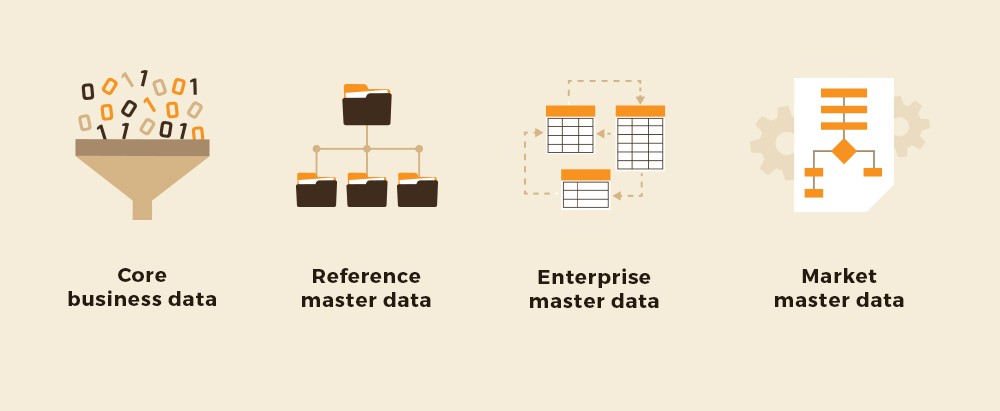
As organisations grow, there is a need to manage data more efficiently -- data system becomes efficient when its master data and the processes for managing it are defined clearly, as per business needs.

This blog tells us how data governance is different from master data management; how master data can be stored and transmitted across the organisations without any ambiguity.
In a recent article, we looked at why master data management needs to be a part of your data governance framework. At the end of it, you might have had one of the following questions in mind:
Is master data management (MDM) different from data governance?

There are schools of thought that place data governance alongside MDM as a comparable, yet disparate, function; there are also those who believe that data governance is a part of MDM, that an efficient MDM requires you to apply the best practices of data governance to your master data.
Our own perspective on this is completely different: think of MDM as an essential subset of data governance. You cannot have effective, efficient data systems for your organisation unless you have defined your master data and the processes for managing it properly. Therefore, a robust data governance policy requires a robust master data management as one of its building blocks.
What are the different types of master data possible?
Most organisations typically consider their core business data – details about customers, products, rates, accounts, etc. – as master data. These are then referenced in transactional entries, but are rarely modified thereafter.
Building upon this bedrock, organisations might also have reference master data, which often have more to do with meta-data, taxonomy or classification, and aren’t usually subjected to daily updates. Think of account classifications (such as “key account,” “emerging account,” “dormant account”) – these classifications and their definitions will remain static for long periods of time before being rewritten to suit the company’s situation later on.
For enterprises with multiple business units, there must remain some data that can be used for apples-to-apples analysis and benchmarking – that’s enterprise master data. These are the standard values maintained throughout the organisation. Enterprise data is not necessarily exclusive from core business data, and the difference is mainly in the way it is used.
Organisations operating multiple business units in the same market might prefer to store market master data – this enables cross-functional utilisation of data. When you get a call from your bank’s sister concern for mortgages or credit cards, it is the master market data that has enabled it.
.tb_button {padding:1px;cursor:pointer;border-right: 1px solid #8b8b8b;border-left: 1px solid #FFF;border-bottom: 1px solid #fff;}.tb_button.hover {borer:2px outset #def; background-color: #f8f8f8 !important;}.ws_toolbar {z-index:100000} .ws_toolbar .ws_tb_btn {cursor:pointer;border:1px solid #555;padding:3px} .tb_highlight{background-color:yellow} .tb_hide {visibility:hidden} .ws_toolbar img {padding:2px;margin:0px}
How can master data be stored?
Master data is typically stored in a centralised repository, and then shared through replication or transmission as needed. Naturally, the central repository should always have cloned backups as a best practice. This is to facilitate speedy recoveries and switchovers if the central repository breaks down, an insurance policy of sorts for the organisation.
As the organisation grows bigger, it is likely that the master data itself might be fragmented over multiple locations or that copies will be made of the master data to be used locally. While operationally faster, such measures also increase the risk of data corruption. A master data record might end up having multiple versions, perhaps even created at the same time at different points. To protect yourself against this, build into your data governance policy – and particularly your MDM processes – validation and version controls as needed.
How is master data transmitted?
While the master data is secured in central repositories, it cannot serve its purpose unless it is shared with users across the organisation. This can happen through
- Consolidation: when data is collated from different sources into a single master data set.
- Federation: when a virtual view of the master data is stitched together from different sources.
- Propagation: when master data is cloned into another location.
Is master data structure static?
Frequent changes to the master data structure defeats the very purpose of having master data in the first place. But that does not mean that you should never ever change it at all!
As the organisation evolves, so should its master data structure. But this needs to be a considered, well-thought out process involving all the stakeholders. Changes, if any, need to be communicated and tested before being implemented as the next official version of the master data.
What are the tools that can be used for MDM?
There are plenty of tools that can be used for MDM in accordance with your data governance needs. Data warehousing, mining, analysis, federation and virtualisation are some tools that help you determine not only the structure of your master data, but also in extracting the data itself.
In the last and final part of our three-part series, we’ll discuss what it takes to form a robust MDM strategy. Do come back for it.
If you want to know more about MDM and how to set it up in your organisation, talk to our consultants now.


